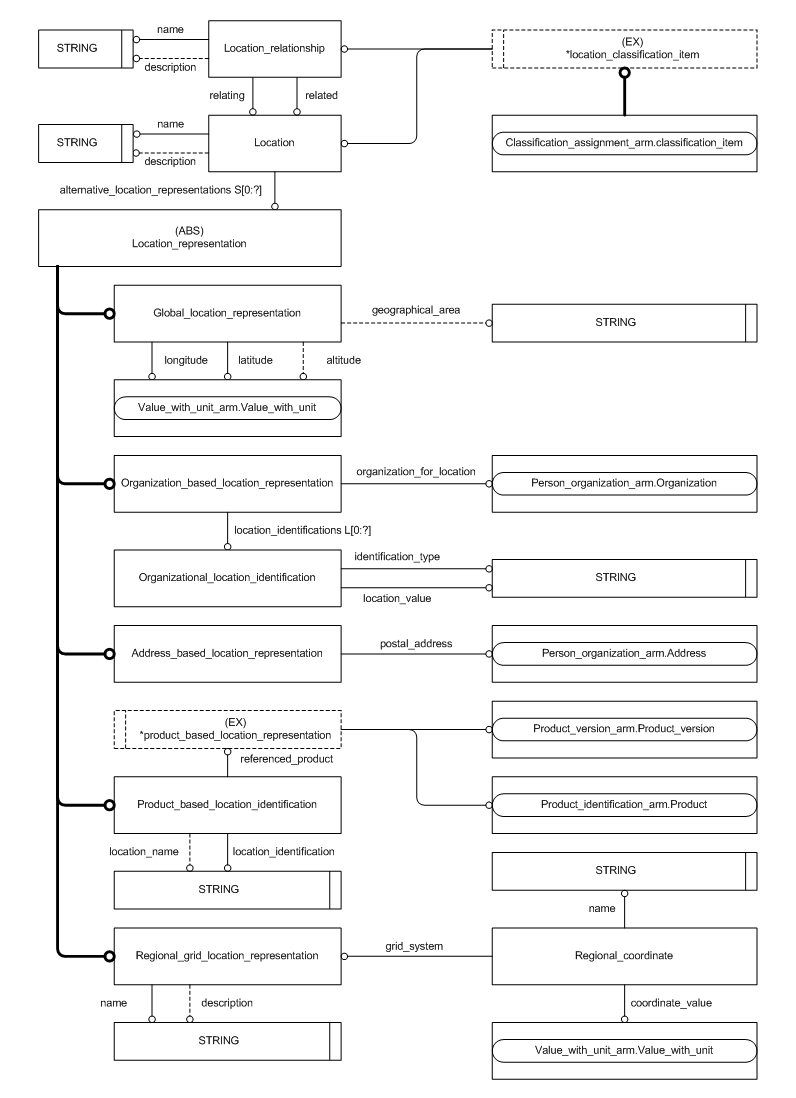
| Capability (C027):— representing_location | Date: 2005/08/15 08:20:35 : Revision: 1.28 |
This section provides a business level overview of this capability.
This capability allows various types of Location_representation to be represented. Each may be associated with a Location through a Location_assignment (see C049: assigning_location), to establish the Location for which it is a representation of. The rules used to determine what actually constitutes a Location are out of scope for this Capability, as, generally, they will be specific to the business needs of the authority assigning the Location Identifier. As a generic concept, a Location should be defined as a bound polyhedron. However, for simplicity, such a location polyhedron can be reduced to a single point in space and still satisfy most business needs. When viewed in this manner, a Location can be defined by at least one from the list of :
This Capability should not be used to describe location within product geometry.
This section provides an overview of the information model that supports this capability.
The information required to represent a Location and Location_representation is summarized in the diagram at Figure 1 below. Details to describe a Location are provided in a separate capability - namely C049: assigning_location which is designed to provide a simple representation. In the following sections, this capability provides guidance on the different alternative Location_representations outlined above.

All locations are given a common name. While this will usually take the form of a plain language string, it is usual for naming authorities to support this with the assignment of some form of formated identifier, suitable for automated processing. Each location may acquire several such identifiers to meet the different needs of the various authorities.
Each instance of Location shall be identified through the assignment of an identifier which has been classified as an "Location identification code" (urn:plcs:rdl:std:Location identification code). This may, for example, be the name associated with a location and can be provided through the use of the template assigning_identification_with_no_organization.
Each instance of Location shall optionally be assigned a classification of[Location_type_code]![]() Error RDL1: The class Location_type_code does not exist in RDL at URI urn:plcs:rdl:std. Check the dexlib/data/refdata/rdl_index.xml
Error RDL1: The class Location_type_code does not exist in RDL at URI urn:plcs:rdl:std. Check the dexlib/data/refdata/rdl_index.xml
. This allows, for example, the location to be characterized using specialisations of this class - see C049: assigning_location for details.
The assigned Location represents a place or position where an Activity or Event can occur, or where a Product or Resource_item can exist. The role that the Location plays in these contexts can be given by classifying the Location_assignment as a type of "Location assignment role" (urn:plcs:rdl:std:Location assignment role). The purpose of the assignment will depend upon each business-specific use but there are several generic sub-classes which may be used (and specialised further where and when necessary). See C049: assigning_location for details.
Each Location may have zero or more alternative_location_representations, and is therefore an optional attribute of location. The subtypes of Location_representation provide the alternative representations of the Location defined and are represented using capability C027: representing_location.
NOTE These alternatives are meant to be alternative representations of the same place defined by the instance of Location that they are an attribute of. For different Locations see the guidance below about "Alternative location" (urn:plcs:rdl:std:Alternative location)s.
Because the concept of a Location is very human, many alternative ways exist as to how it can be represented. These Location_representations offer alternatives in communicating about a location. A strict representation would require the location to be defined by the points of the polyhedron that bounds it. However, only the most demanding users, such as map makers, require this degree of precision. In general, most users are more comfortable with the concept of "place", which can be considered as a notional (and probably undeclared) polyhedron, but which is sufficiently well understood, when associated with one or more identifiers, to serve the business need.
Traditionally, the process of providing a location with an identify has been relatively informal and undisciplined. However, increasing automation is requiring progressively more accurate and consistent representation of the information required to define a location unambiguously for interpretation by machine. The next sections describe each of the different six ways a location may be represented. However, they all have certain aspects in common which shall be described first.
Each instance of Location_representation can be identified through the assignment of an identifier which is a (relevant) sub-classification of "Location identification code" (urn:plcs:rdl:std:Location identification code). For example,
These are associated with the Location_representation through the use of the template assigning_identification_with_no_organization defined within the capability C001: assigning_identifiers.
A Location_representation may additionally be classified by a Classification_assignment using the template assigning_reference_data to provide additional sub-classes of Location_representation. However, the existing subtypes of Location_representation and subclasses provided above should be used in the first instance. Extending the subclasses according to business specific usage is acceptable and should use the subclasses provided for extensions when and if necesssary. Generally, the codes provided are available to classify both identifiers (discussed above) and for classification of the Location_representations when required. However, it is not required to classify the subtypes of Location_representation above unless a further refinement of one of these classes has been determined. Other sub-classifications can be represented by this capability through the extension of the reference data classes above. See capability C010: assigning_reference_data for details.
EXAMPLE An instance of Address_based_location_representation should not be classified as a type of "Address based location identification code" (urn:plcs:rdl:std:Address based location identification code).
An Organization_based_location_representation takes the form of an Organizational_location_identification that is only valid and meaningful in the context of the organization that has assigned it. Classically, these would take the form of name assignments for geographic features of temporary interest, for example "Hill 90".
The representation of an Organization_based_location_representation can be provided through the use of the template representing_organizational_location defined below.
A Global_location_representation defines an absolute position by reference to the geodetic latitude and longitude grid, usually based on the equator and the Greenwich Meridian. To obtain a three dimensional fix, as required, for example, to locate an aircraft in flight, it is also necessary to define an altitude. This is traditionally specified with relation to height above sea level, with negative values indicating a depth.
The representation of an Global_location_representation can be provided through the use of the template representing_geographical_location defined below.
An alternative to the Global Position reference can be achieved by a Regional_grid_location_representation. The most common form of local grids are those established by cartographers and superimposed on their maps. To provide an unambiguous identification, all partners must have access to the definition of the grid origin and orientation.
The representation of an Regional_grid_location_representation can be provided through the use of the template representing_grid_location defined below.
The most common form of location definition is the Address_based_location_representation. Postal Addresses are, generally, assigned by the national postal authority, with the agreement of the local administrative authority, and published in gazetteers.
The representation of an Address_based_location_representation can be provided through the use of the template representing_address_location defined below.
A Product_based_location_identification is used to determine a location within a product structure. In a simple environment, an example could be "the port outer engine". More complex allocations require a reference to the product breakdown structure, including version information, to ensure an unambiguous definition.
The representation of an Product_based_location_identification can be provided through the use of the template representing_product_location![]() Error T1: DEX representing_product_location not in Dexlib
Error T1: DEX representing_product_location not in Dexlib
defined below.
It is sometimes appropriate to identify a Location by reference to another, better defined, Location. For example, it is common maritime practice to define a position by a range and bearing from a known reference point. When this method of location identification is employed, it is necessary for the Location_relationship to be unambiguously defined.
However, there is no relationship in the model between instances ofLocation_representation which indicates that this must be between instances ofLocation and if still required, the different alternative Location_representations can be determined from them. This relationship is described with capability C049: assigning_location.
In short the relationship between two Location instances may be represented using an instance of Location_relationship. The meaning of the relationship can be provided through a classification of the relationship using the template assigning_reference_data. The classification should be a type of "Location relationship role" (urn:plcs:rdl:std:Location relationship role).
C049: assigning_location defines the sub-classes of
"Location relationship role"
(urn:plcs:rdl:std:Location relationship role) but for the purpose of this section, the class [Relative_to_relationship]![]() Error RDL1: The class Relative_to_relationship does not exist in RDL at URI urn:plcs:rdl:std. Check the dexlib/data/refdata/rdl_index.xml
Error RDL1: The class Relative_to_relationship does not exist in RDL at URI urn:plcs:rdl:std. Check the dexlib/data/refdata/rdl_index.xml
may be used. i.e. a classification of a Location_relationship where a different, related_location (dependant) is defined
relative to the relating_location. This type of relationship is frequently used for nautical and orienteering purposes. E.g.
providing a bearing relative to a fixed position or grid).
NOTE To represent both a range and bearing, two instances of Regional_coordinate would be required.
This section specifies how the information model can be further characterized by the assignment of additional information such as dates, approvals and people or organizations.
The following characterizations may apply.
A Location_representation may additionally be characterized by a Calendar_date, or Date_time, through a Date_or_date_time_assignment. The role of the assignment should describe the purpose of the date or time representation used through relevant reference data. Typical classifications include any of the reference data whose root classification is associated with Date_or_date_time_assignment is permissible, such as;
For example, a "Date actual observation" (urn:plcs:rdl:std:Date actual observation) may be required for establishing the time associated with a particular location (such as a global postition) which can be compared with subsequent readings to compute further information, such as speed.
This list is not definitive (nor meant to be). See capability C010: assigning_reference_data for details. It is anticipated that more specific sub-classes of reference data may be produced for with specific business usage requirements.
A Location_representation may also be referenced by a Applied_activity_assignment using the template assigning_activity defined within capability C032: representing_activity. This may provide an additional representation of the location where the referenced Activity may take place.
However, the preferred mechanism for defining a location for this purpose is through the use of an instance of Location as described in C020: representing_life_cycle_opportunity. In this situation, the Location_representation should be treated as an alternative representation in addition to the Location as shown in Figure 1, and described above.
Each instance of Location_representation may have additional identifiers assigned through the assignment of an identifier which is a (relevant) sub-classification of "Location identification code" (urn:plcs:rdl:std:Location identification code). For example,:
These are associated with the Location_representation through the use of the template assigning_identification_with_no_organization defined within the capability C001: assigning_identifiers.
The following sections define a set of templates for the capability, where a template is a specification of a set of entities that need to be instantiated to represent a given set of information.
This section specifies the template representing_address_location.
NOTE An explanation of a template and the associated instantiation path is provided in the Template overview section.


target
is the parameter to which the
Address
is bound.
target
is the parameter to which the
Address_based_location_representation
is bound.
This section specifies the template representing_organizational_location.
NOTE An explanation of a template and the associated instantiation path is provided in the Template overview section.
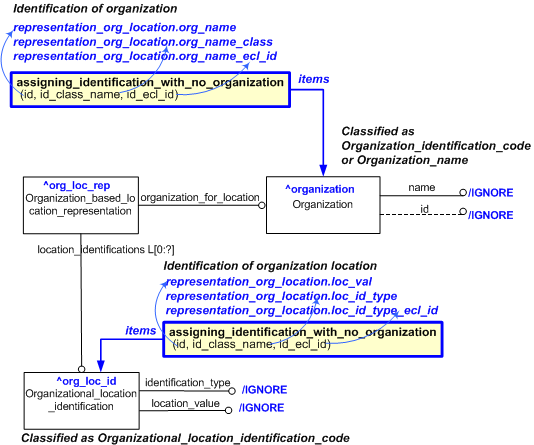

target
is the parameter to which the
Organization
is bound.
-- The template assigning_organization_location has an external reference
-- organization. Bind this to the local external reference
-- Organization. It can now be the target for assignments
%^organization = $assigning_org_location.Organization%
-- assign '123456789' to the organization in the role of "DUNS_code"
/assigning_identification_with_no_organization(items=^organization,
id='123456789',
id_class_name='DUNS_code',
id_ecl_id='urn:plcs:rdl:std')/ target
is the parameter to which the
Organizational_location_identification
is bound.
-- The template assigning_organization_location has an external reference
-- org_loc_id. Bind this to the local external reference
-- Organizational_location_identification. It can now be the target for assignments
%^org_loc_id = $assigning_organization_location.Organizational_location_identification%
-- assign 'DRDL_QGJD' to the location in the role of "Location_identification_code"
/assigning_identification_with_no_organization(items=^org_loc_id,
id='DRDL_QGJD',
id_class_name='Location_identification_code',
id_ecl_id='urn:plcs:rdl:std')/ target
is the parameter to which the
Organization_based_location_representation
is bound.
| Entity in path | Value | Inherited from |
| Organization.name | '/IGNORE' | — |
| Organization.id | '/IGNORE' | — |
| Organizational_location_identification.identification_type | '/IGNORE' | — |
| Organizational_location_identification.location_value | '/IGNORE' | — |
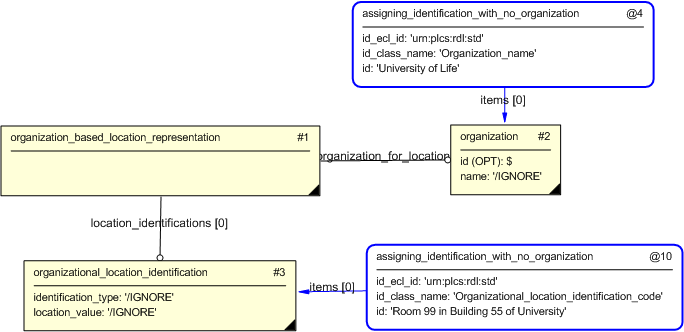
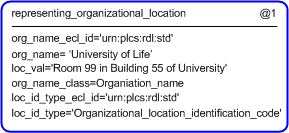
NOTE this characterization is optional.
Where the representation is defined in the context of an alternative location representation, it is recommended that dates be associated with the main Location for which this is an alternative. However, where specifically required dates can be associated with the Organization_based_location_representation instantiated by the template as shown below.
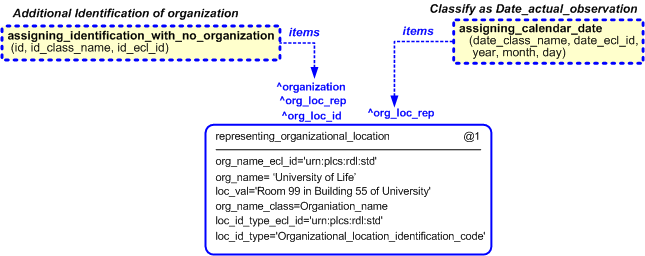
Note this requires the use of the reference parameter
$representing_organizational_location.org_loc_rep to identify the
Organization_based_location_representation
instantiated by the template representing_organizational_location.
NOTE this characterization is optional.
An identifier can be associated with the instance of Organizational_based_location_representation by
using the template
assigning_identification_with_no_organization.
Where required an [Organizational_based_location_identification_code]![]() Error RDL1: The class Organizational_based_location_identification_code does not exist in RDL at URI urn:plcs:rdl:std. Check
the dexlib/data/refdata/rdl_index.xml
Error RDL1: The class Organizational_based_location_identification_code does not exist in RDL at URI urn:plcs:rdl:std. Check
the dexlib/data/refdata/rdl_index.xml
- (i.e. the location within the context of the relevant Organization) can be assigned to an instance of
Organization_based_location_representation. This should be done when more than one instance of
Organization_based_location_representation is referenced in the context of an alternative location.
The model allows for a list of [0:?] Organizational_location_identification instances to be created. The template forces one instance of Organizational_location_identification to be created and one instance of identification_assignment to carry the location and identification type. However, because the location identification instance is accessible outside of the template, any number of assignments can be made to the Organizational_location_identification, if required using the template assigning_identification_with_no_organization. This makes creating a separate instance of for each one superfluous. Thus, it is recommended to create only a single Organizational_location_identification for each representation. There may be 1 or many location and identification types assigned using assigning_identification_with_no_organization for each organization represented.
NOTE The identifier type should be of class "Organizational location identification code" (urn:plcs:rdl:std:Organizational location identification code).
Further identifiers can be associated with the instance of Organization by using the template assigning_identification_with_no_organization. This might include additional organization id codes that can be assigned to an instance of Organization, if required (e.g. CAGE Code, UID..). The assignment should be classified as a type of "Organization identification code" (urn:plcs:rdl:std:Organization identification code) or "Organization name" (urn:plcs:rdl:std:Organization name).
This section specifies the template representing_geographical_location.
NOTE An explanation of a template and the associated instantiation path is provided in the Template overview section.
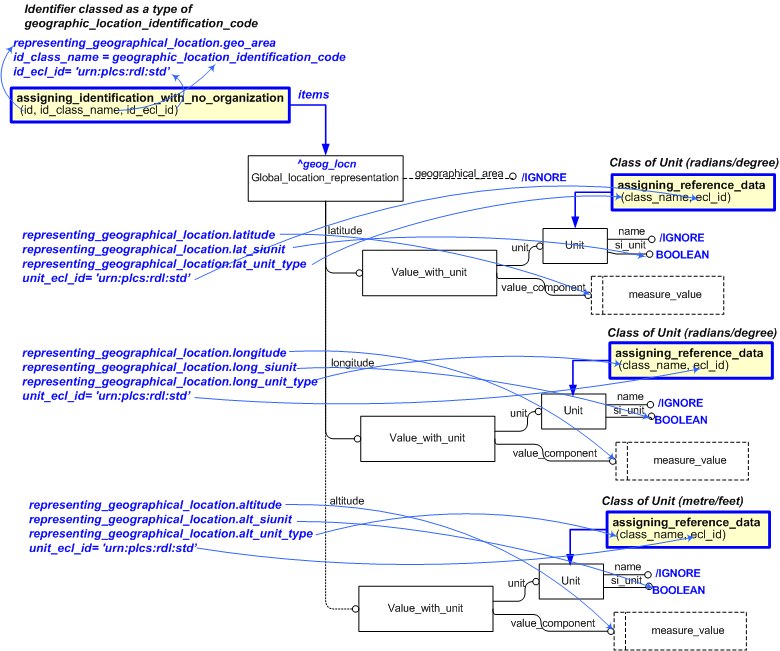
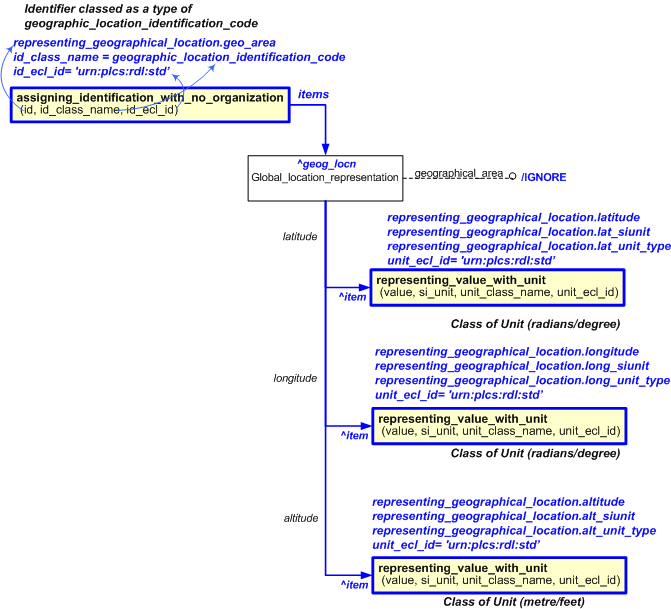

target
is the parameter to which the
Global_location_representation
is bound.
-- The template representing_geographical_location has an external reference
-- geog_locn. It can now be the target for assignments e.g.
%^todays_location = $representing_geographical_location.geog_locn%
-- e.g assign 'wilderness' to the global_location_representation in the role of "Geographic_area"
/assigning_identification_with_no_organization(items=^geog_locn,
id='Wilderness',
id_class_name='Geographic_area',
id_ecl_id='urn:plcs:rdl:std')/ | Entity in path | Value | Inherited from |
| Global_location_representation.geographical_area | '/IGNORE' | — |
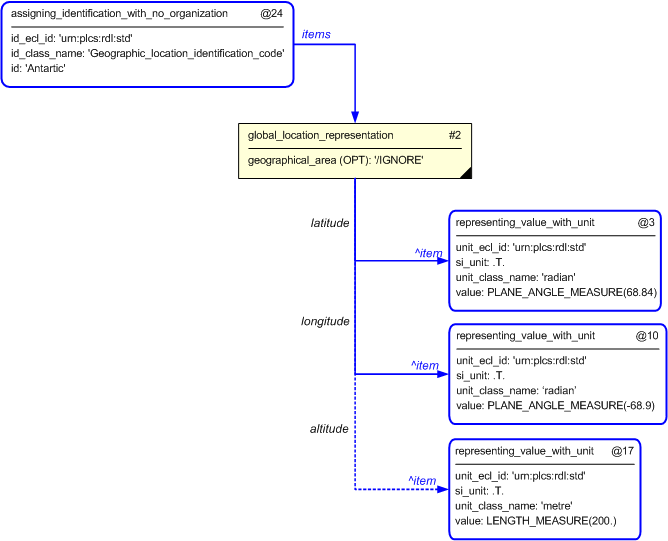
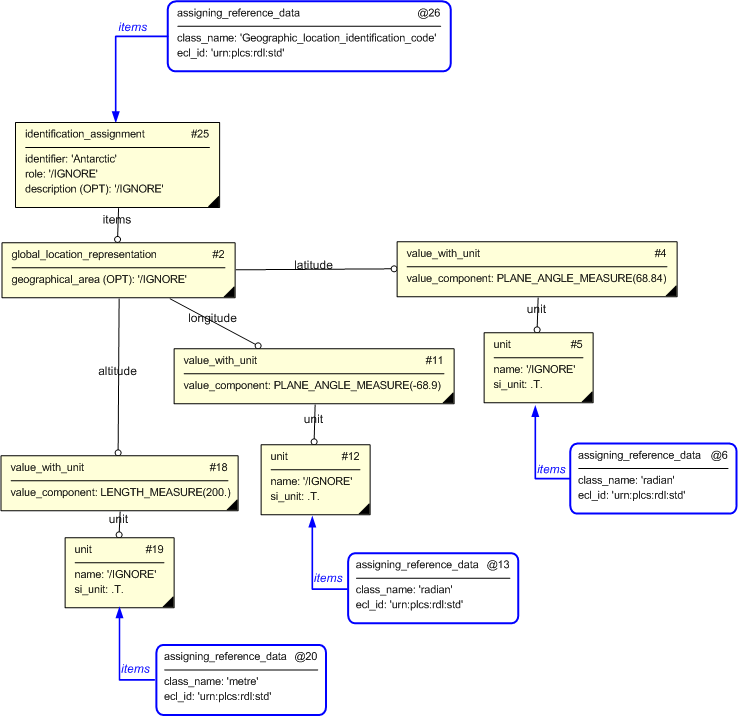
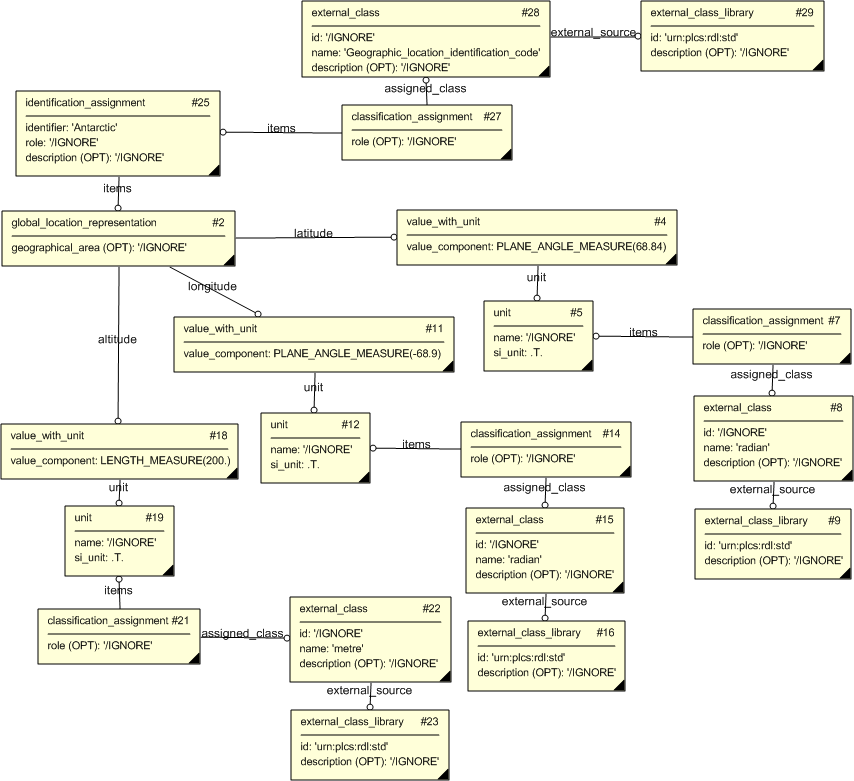
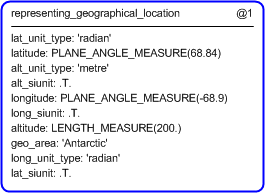
NOTE this characterization is optional.
In general no further characterization of the units is permitted. However, the instance of Global_location_representation, may be characterized as described above in the introduction. See Additional Identification details.
The instance of Global_location_representation, may also be (optionally) referenced as a member of alternative location representations from an instance of Location. This may be be illustrated in the figure below by relating the two templates; assigning_location and representing_geographical_location.
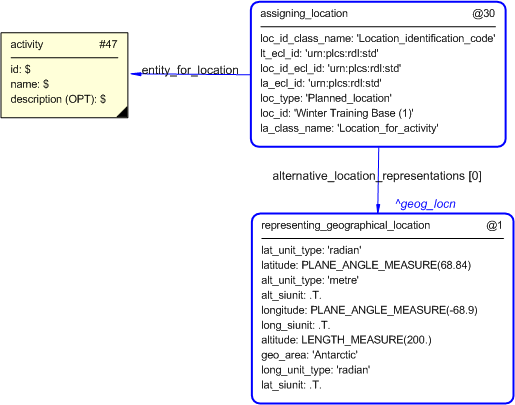
This section specifies the template representing_grid_location.
NOTE An explanation of a template and the associated instantiation path is provided in the Template overview section.


target
is the parameter to which the
Regional_grid_location_representation
is bound.
| Entity in path | Value | Inherited from |
| Regional_coordinate.name | '/IGNORE' | — |
| Regional_grid_location_representation.description | '/IGNORE' | — |
| Regional_grid_location_representation.name | '/IGNORE' | — |
The following classes of reference data are required for this capability:
[Primary_location_representation]© OASIS 2010 — All rights reserved